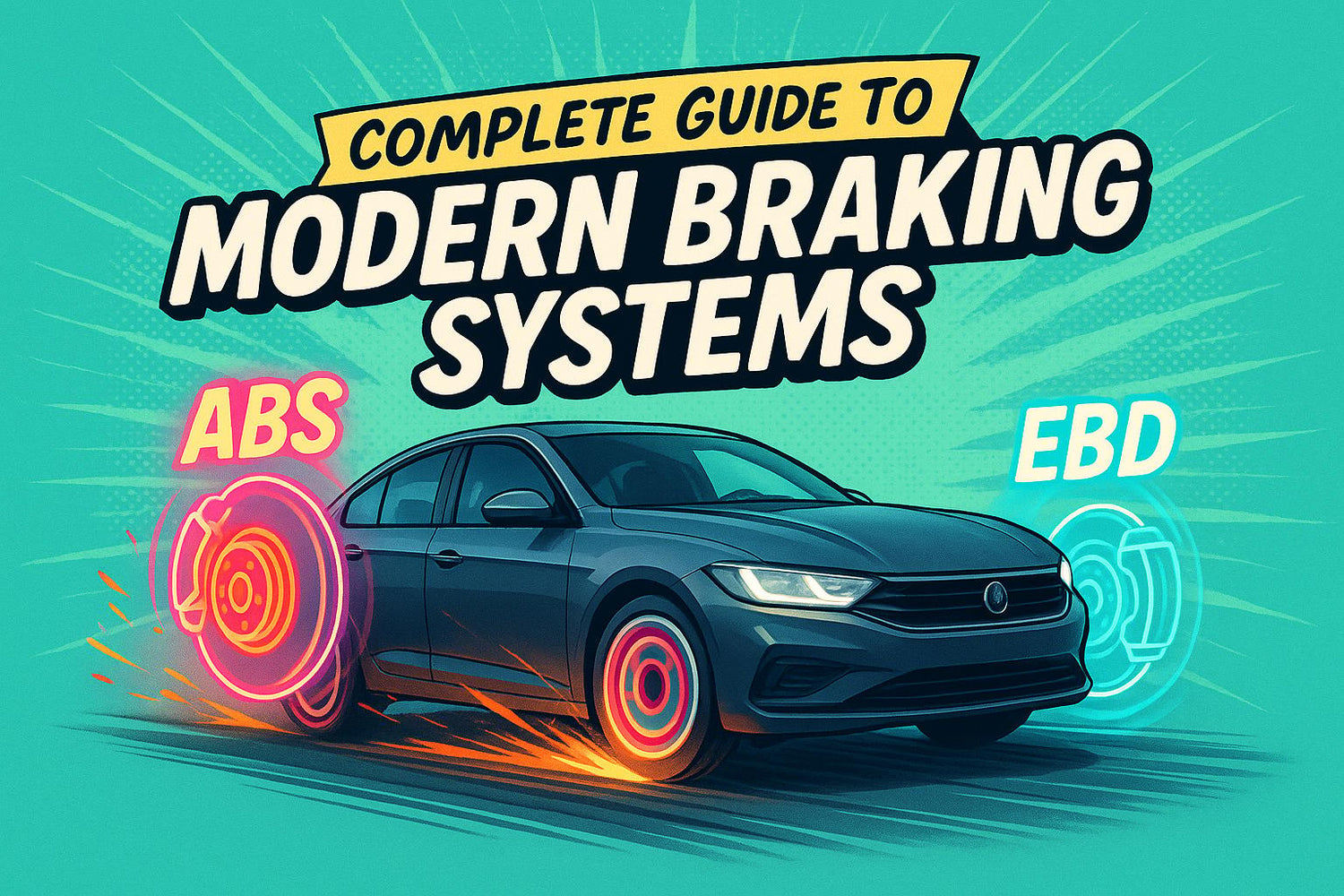In today's world of rapid innovation, the importance of advanced braking systems in vehicles cannot be overstated. From being a simple mechanism in early automobiles to becoming a sophisticated network of safety systems, braking technology has evolved to meet the demands of speed, efficiency, and safety. This comprehensive guide explores the transformative journey of braking systems, their modern advancements, and what it means for drivers navigating the challenges of urban and high-speed environments.
Whether you're a student, a tech-savvy professional, or an eco-conscious commuter, understanding how these systems work can help you make informed choices, enhance your driving experience, and prioritize safety - both for yourself and others on the road.
How Braking Systems Have Evolved
From Basic to Complex: A Historical Perspective
When the first automobiles hit the roads, their braking systems were rudimentary. Early designs were simple because vehicles operated at low speeds, making basic friction-based brakes sufficient. However, as cars became faster and more advanced, the need for more effective braking mechanisms grew.
Modern braking systems are no longer just about stopping a vehicle - they now ensure stability, improve handling, and even prevent accidents in emergencies. This leap in technology has been achieved through the integration of innovative components and auxiliary systems.
Key Types of Braking Systems
Understanding the vast variety of braking systems in use today can be overwhelming. Let’s break them down by purpose, drive mechanism, and working type to get a clearer picture:
1. Types by Purpose
- Service Brakes: The most frequently used system, allowing vehicles to slow down or come to a complete stop. The braking intensity depends on how much pressure the driver applies to the pedal.
- Parking Brakes: Designed to secure stationary vehicles, especially on slopes, by immobilizing the wheels.
- Emergency Backup Brakes: These serve as safeguards in case the main braking system fails. In most passenger cars, the parking brake doubles as the emergency brake.
- Mountain Brakes: Typically found in trucks, these brakes reduce reliance on the main system during downhill driving, preventing overheating and failure.
2. Types by Drive Mechanism
- Mechanical Drive: Uses rods, levers, and cables to transmit braking force. Often employed in parking brakes.
- Hydraulic Drive: The most common system in passenger cars, leveraging the incompressibility of liquid to transmit force efficiently.
- Pneumatic Drive: Popular in commercial vehicles, this system uses compressed air to engage the brakes.
- Combined Drive: Found on specialized equipment, combining different systems for unique applications.
3. Types by Working Mechanism
- Disc Brakes: Widely used in passenger cars, these are highly efficient, lightweight, and compact. They consist of a disc fixed to the wheel hub and pads that create friction to slow rotation.
- Drum Brakes: Common in larger vehicles due to their ability to handle higher forces. While durable and cost-effective, they have slower reaction times compared to disc brakes.
Modern Safety Enhancements
With rising speeds and complex driving conditions, automotive manufacturers have introduced auxiliary systems to complement traditional braking mechanisms. These systems are designed to enhance safety, minimize stopping distances, and improve vehicle handling during emergencies. Let’s dive into the most notable ones:
1. Anti-Lock Braking System (ABS)
Introduced in 1978 by Bosch, ABS prevents wheel lock-up during sudden braking. By maintaining tire traction, ABS ensures stable vehicle control and reduces the risk of skidding. This system has become a standard feature in most modern vehicles.
2. Brake Assist (BA or EBS)
This system detects emergency braking scenarios and amplifies the pressure applied to the brake pedal. Even if a driver doesn’t press the pedal with enough force, BA ensures maximum braking efficiency. It works in tandem with ABS to optimize performance and minimize stopping distance.
3. Dynamic Brake Control (DBC)
Developed by BMW, DBC monitors how quickly and forcefully the brake pedal is pressed. During emergencies, it rapidly increases hydraulic pressure to ensure the shortest possible braking distance. Unlike vacuum-based systems, DBC’s hydraulic design enhances force distribution and precision.
4. Cornering Brake Control (CBC)
Another BMW innovation, CBC addresses the challenges of braking while cornering. It prevents rear-wheel skidding by redistributing braking force to the wheels most in need. This keeps the vehicle stable, even during sharp, high-speed turns.
5. Electronic Brake Force Distribution (EBD)
A vital part of ABS, EBD dynamically allocates braking force between front and rear wheels - or even left and right - based on factors such as load weight, road conditions, and speed. This adaptive system reduces the risk of rear-wheel lock-up and ensures safer, more efficient braking.
Advantages and Challenges of Modern Braking Systems
Disc Brakes:
- Advantages: High efficiency, compact design, excellent reliability.
- Challenges: Susceptible to dirt and debris, which can affect performance.
Drum Brakes:
- Advantages: Durable, effective for heavy vehicles, and affordable.
- Challenges: Slower response time and a tendency for brake pads to stick in extreme weather conditions.
Advanced systems like ABS, BA, DBC, CBC, and EBD mitigate many of these challenges by enhancing overall safety and performance, making modern vehicles more dependable than ever.
Why Understanding Braking Systems Matters
Modern brakes are no longer just mechanical components; they’re intricate systems that work behind the scenes to ensure smooth, safe driving. For drivers, knowing how these systems function - along with their strengths and limitations - can improve decision-making on the road and encourage proactive vehicle maintenance.
Additionally, as governments and manufacturers push for higher safety standards, many of these advanced systems are becoming mandatory in new vehicles, making it essential for drivers to stay informed.
Key Takeaways
- Braking Evolution: Cars have transitioned from basic friction brakes to intricate systems that enhance safety and performance.
- Main Components: Traditional options include disc and drum brakes, each with distinct advantages and use cases.
- Modern Safety Systems: Advanced technologies like ABS, BA, DBC, CBC, and EBD significantly improve handling and reduce stopping distances.
- Hydraulic Efficiency: Hydraulic and pneumatic actuators dominate modern designs, ensuring seamless force transmission with minimal effort.
- Practical Insights: Proper understanding of braking systems promotes safer driving and helps in selecting the right vehicle for specific needs.
- Maintenance is Key: Regular checks are vital to keep your braking system in optimal condition and extend its lifespan.
Conclusion
Modern braking systems have transformed how we drive, blending mechanical simplicity with cutting-edge technology. These advancements don’t just make vehicles safer - they redefine how we approach road safety, efficiency, and mobility. As manufacturers continue to innovate, the future promises even greater strides in braking technology, potentially integrating AI-powered systems to further reduce accidents and improve vehicle handling.
By understanding the principles, mechanisms, and auxiliary technologies behind these systems, drivers can better appreciate their vehicles' capabilities and make informed decisions about maintenance, upgrades, and driving habits.
Stay safe, and let innovation keep paving the way for better driving experiences.
Source: "Explore the Latest Modern Braking Systems for Vehicles: A Comprehensive Guide" - Kyle Walker, YouTube, Aug 26, 2025 - https://www.youtube.com/watch?v=p5D44aNsj3M
Use: Embedded for reference. Brief quotes used for commentary/review.




Leave a comment
All comments are moderated before being published.
This site is protected by hCaptcha and the hCaptcha Privacy Policy and Terms of Service apply.